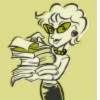 Fleischman, Sid. 1986. THE WHIPPING BOY. New York: Greenwillow Books. ISBN 0-688-06216-4
Fleischman, Sid. 1986. THE WHIPPING BOY. New York: Greenwillow Books. ISBN 0-688-06216-4Jemmy is supposed to “yowl like a stuck pig.” But during the whackings he resolutely holds back his tears. As the whipping boy of Prince Horace (more commonly referred to as Prince Brat), Jemmy has daily opportunities to practice this resolution. Though he no longer has to live in the sewers nor wonder when he will eat next, Jemmy longs to run away from the castle and be free. When the prince decides to run away and drags Jemmy along with him, the two are forced to cooperate with one another in order to survive. Using plot elements from The Prince and the Pauper as well as Aladdin, this story has a familiar feel. However, THE WHIPPING BOY has a higher level of verisimilitude than these traditional stories because of the attention to historical details such as whipping boys, notorious highwaymen, and ballad sellers. Giving further indication of the time period, each plot twist is announced with a lengthy title chapter reminiscent of literature of the middle ages; for example, “Chapter 19 Being a full account of the happenings in the dark sewers.” Other stories set in medieval times such as THE MIDWIFE’S APPRENTICE (K. Cushman) and THE TALE OF DESPEREAUX (K. DiCamillo) employ this use of detailed titles as well. Periodic, monochromatic illustrations by Peter Sis accentuate humorous situations as well as provide the reader with examples of the style of clothing. Fleischman’s spin on a familiar plot and multidimensional characters offer humor (Jemmy’s frequent interjection of incredulity, “gaw!”) and sincerity (“I wish I were like you….You’re not afraid of anything.”) and entice the reader through to a satisfying ending.
This piece of historical fiction earned the Newbery Medal in 1987 and is recommended for readers grades 4-8.

No comments:
Post a Comment